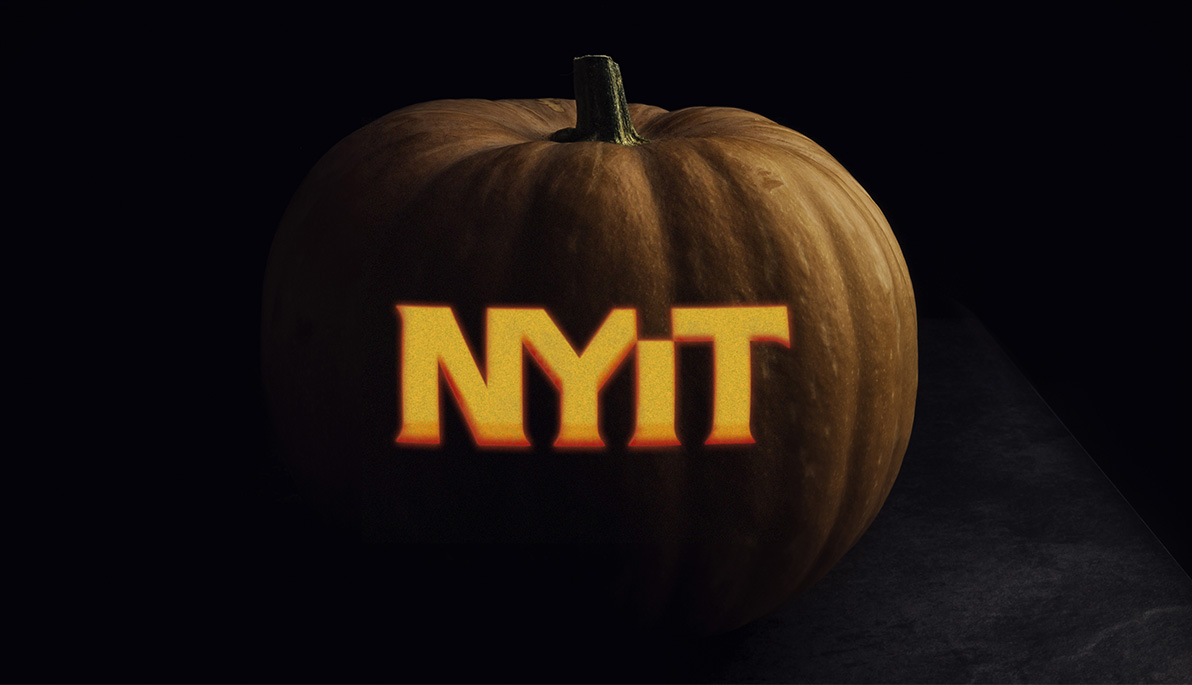
It Came From … The Box!
October 31, 2018
In keeping with the Halloween spirit, NYIT faculty and staff share memories of their most frightening cinematic scares.

John Hyde, executive director, Career Services
“I’m a huge fan of the Terminator movies with Arnold Schwarzenneger and Linda Hamilton. The robotic technology depicted in this series is evermore real in that we are seeing robots doing more than just vacuuming floors, like the Roomba.
“In Singapore and China, there are robots roaming airport terminals answering questions from lost tourists, taking food orders, and doing routine maintenance on planes. I can’t help but believe that when Arnold says “I’ll be back,” he or another version of him certainly will be back!”

Donald Fizzinoglia, M.A., M.S., professor and chair of communication arts, NYIT College of Arts and Sciences
“It might seem rather odd to pick Stanley Kubrick’s 2001: A Space Odyssey (1968) as one of the scariest movies, since, one, it is not universally considered a horror film (although I’ve seen that debated online by cineastes) and two, it is one of my favorites for so many reasons, but not necessarily for its scariness. But scary it is.
“The most chilling aspect is the HAL 9000 computer turning against the very human race responsible for building it/him. HAL’s intellect is superior: his model has never, ever made an error and he is programmed to have an amiable, if not a little superior, human-like personality—qualities seen as great assets. But as the importance of the mission becomes more and more apparent, an unexpected aspect of HAL’s make-up emerges. Perhaps it’s his machine “ego” or perhaps it’s his correct assumption that the humans would somehow mess this up, but when HAL makes this determination, a murderous impulse with no moral filter takes over.
“I think the fact that the film is 50 years old and still holds up as both “science fiction” and as art is amazing! It predicts a frightening future, perhaps a few decades off in estimating the advances of artificial intelligence, but it is no less unsettling. The future’s not here … yet.”

Simone Hoffmann, Ph.D., assistant professor, NYIT College of Osteopathic Medicine
“Maybe not scariest, but one that I find very interesting is Arrival (2016) because it doesn’t just focus on shocking effects and attacks but how to actually communicate and build a language and how easy it is to misinterpret different languages. I found the depiction of how different people and cultures react to the unknown realistic.”

Giovanni Santamaria, associate professor, NYIT School of Architecture and Design
“Existenz (1999) by David Cronenberg depicts a scenario where the threshold between reality and imagination is completely blurred, mediated by a technology that is so sophisticated to become a sort of organic prosthesis of the human body. Gattaca (1997) by Andrew Niccol is more about the conflicts between the perfection reachable through scientific and technological control of human potentials and the limits of organic nature within a very sterile and futuristic environment. And finally, Cube (1997) by Vincenzo Natali is a metaphor of the universe within a limitless combination of variable paths towards freedom.”

Stan Silverman, M.S., professor, NYIT School of Interdisciplinary Studies and Education
“When I was a kid, a movie that horrified me was King Kong (1933). I had images of a supersized gorilla stumping through the trees to trample me while fighting dinosaurs. But it wasn’t long until [I drew on] the convergence of math and science, and turned my fear into pity for the King.
“Physical objects have both volume and surface area, but sadly for King Kong, they don’t increase at the same rate. The volume increases at a power of three and the surface area at a power of two. The amount of air and food you require, the amount of waste products you create, and the heat that you generate are a function of volume. However, our ability to intake air, absorb food, excrete our wastes, and eliminate heat is a function of surface area. If King Kong was 10 times our size, his volume would increase by a factor of 1,000, while his surface area would only increase by a factor of 100. That would leave my once feared friend standing in place, constantly gasping for breath, sweating buckets, and (sadly for him and us) excreting solids and liquids at an unending rate. My only fear at that point would be how to avoid the smell!”
More Features

An Alumnus’ Commitment to the Environment
As an energy management graduate from New York Tech’s Vancouver campus, Jasdeep Gulati (M.S. ’22) is highly invested in educating people about environmental and climate sustainability.

Vancouver Faculty Win University-Sponsored Research Awards in New Program
The new Global Impact Research Grant (GIRG) program has been developed to keep Vancouver-based faculty connected to faculty and research projects being conducted on the university’s New York campuses.

Studying Climate Change One Degree at a Time
Junhua Qu (M.S. ’24) began her collegiate journey in Beijing. But, her interest in climate change took her to New York Tech’s Vancouver campus to study energy management.

